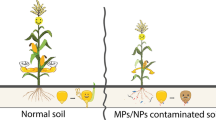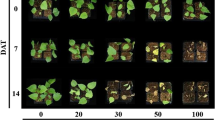Abstract
Present investigation deals with cytogenetical consequences (using attributes namely, seed germination, seedling length, mitotic index, mitotic and meiotic abnormalities and pollen grain sterilities) of cadmium sulphide (CdS) and copper oxide (CuO) nanoparticles (NPs) treatment in Coriandrum sativum L. (Family: Apiaceae, spice of commerce). Ethyl methanesulphonate (EMS), a conventional mutagen is used as positive control. Results suggest that both CdS- and CuO-NPs can induce growth inhibition and cause cytological aberrations in both mitotic and meiotic cells in the studied species. EMS also responds similarly as that of NPs. Study highlights that rooted plant species can be effectively used as model for assessment of nanotoxicity considering cytogenetical parameters.
Similar content being viewed by others
References
Roco, M.C., Broader societal issues of nanotechnology, J. Nanopart. Res., 2003, vol. 5, pp. 181–189.
Scrinis, G. and Lyons, K., The emerging nano-corporate paradigm: nanotechnology and the transformation of nature, food and agri-food systems, Int. J. Sociol. Agric. Food, 2007, vol. 15, no. 2, pp. 22–44.
Nair, R., Varghese, S.H., Nair, B.G., Maekawa, T., Yoshida, Y., and Kumar, D.S., Nanoparticulate material delivery to plants, Plant Sci., 2010, vol. 179, no. 3, pp. 154–163. org/doi 10.1016/j.plantsci.2010.04.012
Philip, D., Rapid green synthesis of spherical gold nanoparticles using Mangifera indica leaf, Spectrochim Acta. A Mol. Biomol. Spectrosc., 2010, vol. 77, pp. 807–810.
Remédios, C., Rosrio, F., and Bastos, V., Environmental nanoparticles interactions with plants: morphological, physiological, and genotoxic aspects, J. Bot., 2012, vol. 2012, pp. 1–8. org/doi 10.1155/2012/751686
Masarovičová, E. and Král'ová, K., Metal nanoparticles and plants, Ecol. Chem. Eng. Soc., 2013, vol. 20, no. 1, pp. 9–22. org/doi 10.2478/eces-2013-0001
Biswas, P. and Wu, C.Y., Nanoparticles and the environment, J. Air Waste Manag. Assoc., 2005, vol. 55, no. 6, pp. 708–46.
Nowack, B. and Bucheli, T.D., Occurrence, behavior and effects of nanoparticles in the environment, Environ. Pollut., 2007, vol. 150, pp. 5–22.
Buzea, C., Pacheco, I.I., and Robbie, K., Nanomaterials and nanoparticles: sources and toxicity, Biointerphases, 2007, vol. 2, no. 4, pp. MR17–MR71.
Tervonen, T., Linkov, I., Figueira, J.R., Steevens, J., Chappell, M., and Merad, M., Risk-based classification system of nanomaterial, J. Nanopart. Res., 2009, vol. 11, no. 4, pp. 757–66. doi 10.1007/s11051-008-9546-1
Lidén, G., The European commission tries to define nanomaterials, Ann. Occup. Hyg., 2011, vol. 55, no. 1, pp. 1–5. doi 10.1093/annhyg/meq092
Rico, C.M., Majumdar, S., Duarte-Gardea, M., Peralta-Videa, J.R., and Gardea-Torresdey, J.L., Interaction of nanoparticles with edible plants and their possible implications in the food chain, J. Agric. Food Chem., 2011, vol. 59, no. 8, pp. 3485–3498. doi 10.1021/jf104517j
Pillai, K.V., Gray, P.J., Tien, C.C., Bleher, R., Sung, L.P., and Duncan, T.V., Environmental release of core-shell semiconductor nanocrystals from free-standing polymer nanocomposite films, Environ. Sci. Nano, 2016, vol. 3, no. 3, pp. 657–669.
Borovaya, M.N., Naumenko, A.P., Matvieieva, N.A., Blume, Ya.B., and Yemets, A.I., Biosynthesis of luminescent CdS quantum dots using plant hairy root culture, Nanoscale Res. Lett., 2014, vol. 9, p. 686. doi 10.1186/1556-276X-9-686
Dhineshbabu, N.R., Rajendran, V., Nithyavathy, N., and Vetumperumal, R., Study of structural and optical properties of cupric oxide nanoparticles, Appl. Nanosci., 2016, vol. 6, no. 6, pp. 933–939.
Kumari, M., Mukherjee, A., and Chandrasekaran, N., Genotoxicity of silver nanoparticles in Allium cepa, Sci. Total Environ., 2009, vol. 407, no. 19, pp. 5243–5246. doi 10.1016/j.scitotenv.2009.06.024
Castiglione, M.R., Giorgetti, L., Geri, C., and Cremonini, R., The effects of nano-TiO2 on seed germination, development and mitosis of root tip cells of Vicia narbonensis L. and Zea mays L., J. Nanopart. Res., 2011, vol. 13, no. 6, pp. 2443–2449.
Patlolla, A.K., Berry, A., May, L., and Tchounwou, P.B., Genotoxicity of silver nanoparticles in Vicia faba: a pilot study on the environmental monitoring of nanoparticles, Int. J. Environ. Res. Public Health, vol. 9, no. 5, pp. 1649–1662. doi 10.3390/ijerph9051649
Nagaonkar, D., Shende, S., and Rai, M., Biosynthesis of copper nanoparticles and its effect on actively dividing cells of mitosis in Allium cepa, Biotechnol. Prog., 2015, vol. 31, no. 2, pp. 557–565. doi 10.1002/btpr.2040
Kumbhakar, D.V., Datta, A.K., and Mandal, A., Das D., Gupta S., Ghosh B., Halder S., Dey S. Effectivity of copper and cadmium sulphide nanoparticles in mitotic and meiotic cells of Nigella sativa L. (black cumin)—can nanoparticles act as mutagenic agents?, J. Exp. Nanosci., 2016, vol. 11, no. 11, pp. 823–839. doi.org/doi 10.1080/17458080.2016.1149236
Halder, S., Mandal, A., Das, D., Datta, A.K., Chattopadhyay, A.P., Gupta, S., and Kumbhakar, D.V., Effective potentiality of synthesised CdS nanoparticles in inducing genetic variation on Macrotyloma uniflorum (Lam.) Verdc., BioNanoScience, 2015, vol. 5, no. 3, pp. 171–180. doi 10.1007/s12668-015-0176-7
Marks, G.E., An aceto-carmine glycerol jelly for use in pollen-fertility counts, Stain Technol., 1954, vol. 29, no. 5, p. 277.
Lin, D. and Xing, B., Phytotoxicity of nanoparticles: inhibition of seed germination and root growth, Environ. Pollut., 2007, vol. 150, no. 2, pp. 243–250. doi 10.1016/j.envpol.2007.01.016
Lin, D. and Xing, B., Root uptake and phytotoxicity of ZnO nanoparticles, Environ. Sci. Technol., 2008, vol. 42, no. 15, pp. 5580–5585.
Stampoulis, D., Sinha, S.K., and White, J.C., Assaydependent phytotoxicity of nanoparticles to plants, Environ. Sci. Technol., 2009, vol. 43, no. 24, pp. 9473–9479. doi 10.1021/es901695c
Tan, X.M., Lin, C., and Fugetsu, B., Studies on toxicity of multi-walled carbon nanotubes on suspension rice cells, Carbon, 2009, vol. 47, no. 15, pp. 3479–33487.
Mushtaq, Y.K., Effect of nanoscale Fe3O4, TiO2 and carbon particles on cucumber seed germination, J. Environ. Sci. Health Tox. Hazard Subst. Environ. Eng., 2011, vol. 46, no. 14, pp. 1732–1735. doi.org/doi 10.1080/10934529.2011.633403
Atha, D.H., Wang, H., Petersen, E.J., Cleveland, D., Holbrook, R.D., Jaruga, P., Dizdaroglu, M., Xing, B., and Nelson, B.C., Copper oxide nanoparticles mediated DNA damage in terrestrial plant models, Environ. Sci. Technol., 2012, vol. 46, no. 3, pp. 1819–1827. doi 10.1021/es202660k
Shaymurat, T., Gu, J., Xu, C., Yang, Z., Zhao, Q., Liu, Y., and Liu, Y., Phytotoxic and genotoxic effects of ZnO nanoparticles on garlic (Allium sativum L.): a morphological study, Nanotoxicology, 2012, vol. 6, no. 3, pp. 241–248. doi 10.3109/17435390.2011.570462
Lu, C.M., Zhang, C.Y., Wen, J.Q., Wu, G.R., and Tao, M.X., Research of the effect of nanometer materials on germination and growth enhancement of Glycine max and its mechanism, Soybean Sci., 2002, vol. 21, no. 3, pp. 168–171.
Lin, B.S., Diao, S.Q., Li, C.H., Fang, L.J., Qiao, S.C., and Yu, M., Effects of TMS (nanostructured silicon dioxide) on growth of Changbai larch seedlings, J. For. Res., 2004, vol. 15, pp. 138–140.
Zheng, L., Hong, F., Lu, S., and Liu, C., Effect of nano-TiO2 on strength of naturally aged seeds and growth of spinach, Biol. Trace. Elem. Res., 2005, vol. 104, pp. 83–91.
Raskar, S.V. and Laware, S.L., Effect of zinc oxide nanoparticles on cytology and seed germination in onion, Int. J. Curr. Microbiol. App. Sci., 2014, vol. 3, no. 2, pp. 467–473.
Lee, H.L., Issam, A.M., Belmahi, M., Assouar, M.B., Rinnert, H., and Alnot, M., Thermal and optical properties of CdS nanoparticles in thermotropic liquid crystal monomers, Materials, 2010, vol. 3, pp. 2069–2086. doi 10.3390/ma3032069
Moustafa, Y., Physiological and cytogenetic responses of wheat and barley to silver nanopriming treatment, Int. J. App. Biol. Pharma Technol., 2014, vol. 5, no. 3, pp. 265–278.
Amato, F., The cytological study of chemical mutagens, Genet. Iberica, 1952, vol. 4, pp. 3–20.
Datta, A.K., Biswas, A.K., and Sen, S., Gamma radiation sensitivity in Nigella sativa L., Cytologia, 1986, vol. 51, no. 3, pp. 609–615. doi.org/doi10.1508/cytologia. 51.609
Sparrow, A.H., Mosses, M.J., and Steel, R., Cytological and cytochemical approach to an understanding of radiation damage in dividing cells, Brit. J. Radiol., 1952, vol. 25, no. 292, pp. 182–188.
Gaulden, M.E., Hypothesis: Some mutagens directly alter specific chromosomal proteins (DNA topoisomerease II and peripheral proteins) to produce chromosome stickiness, which causes chromosome aberrations, Mutagenesis, 1987, vol. 2, no. 5, pp. 357–365.
Akhtar, A., Ansari, M.Y.K., and Hisamuddin, A., Cytological effect of ethyl methane sulphonate and sodium, Int. J. Plant Animal Environ. Sci., 2012, vol. 2, pp. 70–75.
Kozgar, M.I., Hussain, S., Wani, M.R., and Khan, S., The role of cytological aberrations in crop improvement through induced mutagenesis, Imp. Crops Era Clim. Changes, 2014, vol. 2, pp. 283–296.
Khursheed, S., Laskar, R.A., Raina, A., Amin, R., and Khan, S., Comparative analysis of cytological abnormalities induced in Vicia faba L. genotypes using physical and chemical mutagenesis, Chromosome Sci., 2015, vol. 18, nos. 3–4, pp. 47–51.
Blixt, S., Studies on induced mutations in peas VIII. Ethylene imine and gamma ray treatment of the variety Witham wonder, Agric. Hort. Genet., 1964, vol. 22, pp. 171–183.
Ghosh, A. and Datta, A.K., Karyotyping of Nigella sativa L. (black cumin) and Nigella damascene L. (lovein-a-mist) by image analyzing system, Cytologia, 2006, vol. 71, no. 1, pp. 1–4.
Canas, J.E., Long, M., Nations, S., Vadan, R., Dai, L., Luo, M., Ambikapathi, R., Lee, E.H., and Olszyk, D., Effects of functionalized and non-functionalized single-walled carbon nanotubes on root elongation of select crop species, Environ. Toxicol. Chem., 2008, vol. 27, no. 9, pp. 1922–1931.
El-Temsah, Y.S. and Joner, E.J., Impact of Fe and Ag nanoparticles on seed germination and differences in bioavailability during exposure in aqueous suspension and soil, Environ. Toxicol., 2012, vol. 27, no. 1, pp. 42–49.
Ma, Y., Kuang, L., He, X., Bai, W., Ding, Y., Zhang, Z., Zhao, Y., and Chai, Z., Effect of rare earth oxide nanoparticles on root elongation of plants, Chemosphere, 2010, vol. 78, no. 3, pp. 273–279.
Rico, C.M., Majumdar, S., Duarte-Gardea, M., Peralta-Videa, J.R., and Gardea-Torresdey, J.L., Interaction of nanoparticles with edible plants and their possible implications in the food chain, J. Agric. Food Chem., 2011, vol. 59, no. 8, pp. 3485–3498.
Yang, L. and Watts, D.J., Particle surface characteristics may play an important role in phytotoxicity of alumina nanoparticles, Toxicol. Lett., 2005, vol. 158, no. 4, pp. 122–32.
Author information
Authors and Affiliations
Corresponding author
Additional information
The article is published in the original.
About this article
Cite this article
Pramanik, A., Datta, A.K., Das, D. et al. Assessment of Nanotoxicity (Cadmium Sulphide and Copper Oxide) Using Cytogenetical Parameters in Coriandrum sativum L. (Apiaceae). Cytol. Genet. 52, 299–308 (2018). https://doi.org/10.3103/S0095452718040084
Received:
Published:
Issue Date:
DOI: https://doi.org/10.3103/S0095452718040084




